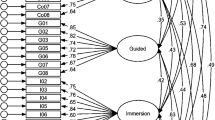Abstract
This paper presents an experimental research that focuses on collaboration in a multi-player game. The aim of the project is to study the cognitive impacts of awareness tools, i.e., artifacts that allow users of a collaborative system to be aware of what is going on in the joint virtual environment. The focus is on finding an effect on performance as well as on the representation an individual builds of what his partner knows, plans and intends to do (i.e., mutual modeling). We find that using awareness tools has a significant effect by improving task performance. However, the players who were provided with this tool did not show any improvement of their mutual modeling. Further analysis on contrasted groups revealed that there was an effect of the awareness tool on mutual modeling for players who spent a large amount of time using the tool.
Similar content being viewed by others
References
Collazos C, Guerrero L, Pino J, Ochoa S (2002) Introducing knowledge-shared awareness. In Proc. of IASTED international conference: information and knowledge sharing (IKS 2002). St. Thomas, Virgin Islands, USA, pp 13–18
David JMN, Borges MRS (2001) Selectivity of Awareness Components in Asynchronous CSCW Environments. In Proc. of the 9th International Workshop on Groupware, CRIWG. Darmstadt, Germany, pp 115–124
Decortis F, Noirfalise S, Saudelli B (1997) Cognitive ergonomics as a framework for cooperative work. Theoretical approaches for analysing cooperative technologies for complex work settings. Report of Work Package 1, EU-TMR Network COTCOS. University of Sussex, Sussex
Dillenbourg P (1999) What do you mean by collaborative learning?. In: Dillenbourg P (ed) Collaborative learning: cognitive and computational approaches. Elsevier, Oxford, pp 1–19
Dourish P, Bellotti V (1992) Awareness and coordination in shared workspaces. In Proc. of ACM CSCW’92 conference on computer supported cooperative work. Toronto, Canada, pp 107–114
Ellis C, Gibbs S, Rein G (1991) Groupware: some issues and experiences. Commun ACM 34(1):38–58
Espinosa A, Cadiz J, Rico-Gutierrez L, Kraut R, Scherlis W, Lautenbacher G (2000) Coming to the wrong decision quickly: why awareness tools must be matched with appropriate tasks. In Proc. of the CHI Conference on Human factors in computing systems. The Hague, The Netherlands, pp 392–399
Fussell SR, Krauss RM (1992) Coordination of knowledge in communication: effects of speakers’ assumptions about what others know. J Pers Soc Psychol 62(3):378–391
Gaver WW (1991) Sound support for collaboration. In Proc. of ECSCW 91. Dordrecht, The Netherlands, pp 293–308
Greenberg S, Gutwin C, Cockburn A (1996) Awareness through fisheye views in relaxed-WYSIWIS groupware. In Proc. of the graphics interface conference. Toronto, Canada, pp 28–38
Grudin J (1994) Computer-supported cooperative work: its history and participation. IEEE Computer 27(5):19–26
Gutwin C, Greenberg S (1999) A framework of awareness for small groups in shared-workspace groupware. Technical Report 99–1, Department of Computer Science, University of Saskatchewan, Canada
Gutwin C, Greenberg S (1999) The effects of workspace awareness support on the usability of real-time distributed groupware. ACM Trans Comput-Hum Interact 6(3):243–281
Gutwin C, Roseman M, Greenberg S (1996) A usability study of awareness widgets in a shared workspace groupware system. In Proc. of the ACM conference on computer supported cooperative work. Boston, USA, pp 258–267
Heath C, Luff P (1992) Collaboration and control: crisis management and multimedia technology in london underground line control rooms. CSCW: The Journal of Collaborative Computing 1(1–2):69–94
Heider F (1958) The psychology of interpersonal relations. Wiley, New York
Isaacs H, Tang JC, Morris T (1996) Piazza: a desktop environment supporting impromptu and planned interactions. In Proc. of ACM CSCW’96. Boston, USA., pp 315–324
Isaacs H, Walendowski A, Ranganathan D (2002) Hubbub: a sound-enhanced mobile instant messenger that supports awareness and opportunistic interactions. In Proc. of the Conference Computer–Human Interaction (CHI). Minneapolis, USA, pp 179–186
Jang CY, Steinfield C, Pfaff B (2002) Virtual team awareness and groupware support: an evaluation of the TeamSCOPE system. Int J Human-Comput Stud 56:109–126
Krauss RM, Fussell SR (1991) Perspective-taking in communication: the determination of others’ knowledge and referential language use. Social Cogn 9(1):2–24
Ljungstrand P, Segerstad YH (2000) An analysis of webwho : how does awareness of presence affect written messages? In Proc. of the int. workshop on awareness and the WWW, ACM CSCW’2000 conference. Philadelphia, USA, available on-line at http://www2.mic.atr.co.jp/dept2/awareness
Mastrogiacomo S (2002) Utilisation des zones de travail partagées asynchrones pour améliorer la compréhension mutuelle dans les groupes de projet distribués. Ph.D. Thesis, Université de Lausanne, June
Matusov E (1996) Intersubjectivity without agreement. Mind Cult Act 3(1):25–47
Nickerson RS, Baddeley A, Freeman B (1987) Are people estimates of what other people know influenced by what they themselves know?. Acta Psychol 64:245–259
Ogata H, Yano Y (2000) Combining knowledge awareness and information filtering in an open-ended collaborative learning environment. Int J Artif Intell Educ 11:33–46
Ott D, Dillenbourg P (2002) Proximity and view awareness to reduce referential ambiguity in a shared 3D virtual environment. In Proc. of computer supported collaborative learning 2002. Boulder, Colorado, USA, pp 603–604
Schmidt K (2002) The problem with “awareness”: introductory remarks on “awareness in CSCW”.CSCW: The Journal of Collaborative Computing 11(3–4):285–298
Sohlenkamp M (1999) Supporting group awareness in multi-user environments through perceptualization. Technical Report No. 6, GMD Institute, Germany
Stefik M, Bobrow D, Foster G, Lanning S, Tatar D (1997) ≪ WYSIWIS revised: early experiences with multi-user interfaces ≫. ACM TOIS 5(2):147–167
Stefik M, Foster G, Bobrow D, Kahn K, Lanning S, Suchman L (1987) Beyond the chalkboard: computer support for collaboration and problem solving in meetings. Commun ACM 30(1):32–47
Wegner DM (1987) Transactive memory: a contemporary analysis of the group mind. In: Mullen B, Goethals GR (eds) Theories of group behavior. Springer, Berlin Heidelberg New York, pp 185–208
Wertsch JV (1985) Vygotsky and the social formation of mind. Harvard University, Cambridge, MA
Won M, Pipek V (2004) Sharing knowledge on knowledge—the eXact peripheral expertise awareness system. J UCS 9(12):1388–1397
Author information
Authors and Affiliations
Corresponding author
Rights and permissions
About this article
Cite this article
Nova, N., Wehrle, T., Goslin, J. et al. Collaboration in a multi-user game: impacts of an awareness tool on mutual modeling. Multimed Tools Appl 32, 161–183 (2007). https://doi.org/10.1007/s11042-006-0065-8
Published:
Issue Date:
DOI: https://doi.org/10.1007/s11042-006-0065-8




